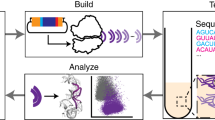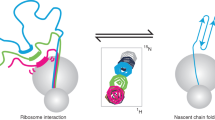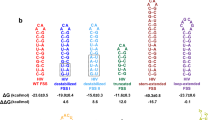Abstract
The ribosome is a 2.5-MDa molecular machine that synthesizes cellular proteins encoded in mRNAs1. The 30S and 50S subunits of the ribosome associate through structurally defined intersubunit bridges2,3,4,5 burying 6,000 Å2, 80% of which is buried in conserved RNA-RNA interactions6. Intersubunit bridges bind translation factors7,8, may coordinate peptide bond formation and translocation9,10,11 and may be actively remodeled in the post-termination complex12,13, but the functional importance of numerous 30S bridge nucleotides had been unknown. We carried out large-scale combinatorial mutagenesis and in vivo selections on 30S nucleotides that form RNA-RNA intersubunit bridges in the Escherichia coli ribosome. We determined the covariation and functional importance of bridge nucleotides, allowing comparison of the structural interface and phylogenetic data to the functional epitope. Our results reveal how information for ribosome function is partitioned across bridges, and suggest a subset of nucleotides that may have measurable effects on individual steps of the translational cycle.
This is a preview of subscription content, access via your institution
Access options
Subscribe to this journal
Receive 12 print issues and online access
$259.00 per year
only $21.58 per issue
Buy this article
- Purchase on Springer Link
- Instant access to full article PDF
Prices may be subject to local taxes which are calculated during checkout





Similar content being viewed by others
Accession codes
References
Ramakrishnan, V. Ribosome structure and the mechanism of translation. Cell 108, 557–572 (2002).
Frank, J. et al. A model of the translational apparatus based on a three-dimensional reconstruction of the Escherichia coli ribosome. Biochem. Cell Biol. 73, 757–765 (1995).
Gabashvili, I.S. et al. Solution structure of the E. coli 70S ribosome at 11.5 A resolution. Cell 100, 537–549 (2000).
Yusupov, M.M. et al. Crystal structure of the ribosome at 5.5 A resolution. Science 292, 883–896 (2001).
Schuwirth, B.S. et al. Structures of the bacterial ribosome at 3.5 A resolution. Science 310, 827–834 (2005).
Mears, J.A. et al. Modeling a minimal ribosome based on comparative sequence analysis. J. Mol. Biol. 321, 215–234 (2002).
Tapprich, W.E., Goss, D.J. & Dahlberg, A.E. Mutation at position 791 in Escherichia coli 16S ribosomal RNA affects processes involved in the initiation of protein synthesis. Proc. Natl. Acad. Sci. USA 86, 4927–4931 (1989).
Cunningham, P.R., Nurse, K., Weitzmann, C.J. & Ofengand, J. Functional effects of base changes which further define the decoding center of Escherichia coli 16S ribosomal RNA: mutation of C1404, G1405, C1496, G1497, and U1498. Biochemistry 32, 7172–7180 (1993).
Frank, J. & Agrawal, R.K. A ratchet-like inter-subunit reorganization of the ribosome during translocation. Nature 406, 318–322 (2000).
Gao, H. et al. Study of the structural dynamics of the E. coli 70S ribosome using real-space refinement. Cell 113, 789–801 (2003).
Valle, M. et al. Locking and unlocking of ribosomal motions. Cell 114, 123–134 (2003).
Gao, N. et al. Mechanism for the disassembly of the posttermination complex inferred from cryo-EM studies. Mol. Cell 18, 663–674 (2005).
Hirokawa, G. et al. The role of ribosome recycling factor in dissociation of 70S ribosomes into subunits. RNA 11, 1317–1328 (2005).
Rackham, O. & Chin, J.W. A network of orthogonal ribosome•mRNA pairs. Nat. Chem. Biol. 1, 159–166 (2005).
Hui, A.S., Eaton, D.H. & de Boer, H.A. Mutagenesis at the mRNA decoding site in the 16S ribosomal RNA using the specialized ribosome system in Escherichia coli. EMBO J. 7, 4383–4388 (1988).
Hui, A. & de Boer, H.A. Specialized ribosome system: preferential translation of a single mRNA species by a subpopulation of mutated ribosomes in Escherichia coli. Proc. Natl. Acad. Sci. USA 84, 4762–4766 (1987).
Lee, K., Varma, S., SantaLucia, J., Jr. & Cunningham, P.R. In vivo determination of RNA structure-function relationships: analysis of the 790 loop in ribosomal RNA. J. Mol. Biol. 269, 732–743 (1997).
Morosyuk, S.V., SantaLucia, J., Jr. & Cunningham, P.R. Structure and function of the conserved 690 hairpin in Escherichia coli 16 S ribosomal RNA. III. Functional analysis of the 690 loop. J. Mol. Biol. 307, 213–228 (2001).
Triman, K.L., Peister, A. & Goel, R.A. Expanded versions of the 16S and 23S ribosomal RNA mutation databases (16SMDBexp and 23SMDBexp). Nucleic Acids Res. 26, 280–284 (1998).
Santer, M. et al. Base changes at position 792 of Escherichia coli 16S rRNA affect assembly of 70S ribosomes. Proc. Natl. Acad. Sci. USA 87, 3700–3704 (1990).
Ghosh, S. & Joseph, S. Nonbridging phosphate oxygens in 16S rRNA important for 30S subunit assembly and association with the 50S ribosomal subunit. RNA 11, 657–667 (2005).
Belanger, F., Gagnon, M.G., Steinberg, S.V., Cunningham, P.R. & Brakier-Gingras, L. Study of the functional interaction of the 900 tetraloop of 16S ribosomal RNA with helix 24 within the bacterial ribosome. J. Mol. Biol. 338, 683–693 (2004).
Nissen, P., Ippolito, J.A., Ban, N., Moore, P.B. & Steitz, T.A. RNA tertiary interactions in the large ribosomal subunit: the A-minor motif. Proc. Natl. Acad. Sci. USA 98, 4899–4903 (2001).
Doherty, E.A., Batey, R.T., Masquida, B. & Doudna, J.A. A universal mode of helix packing in RNA. Nat. Struct. Biol. 8, 339–343 (2001).
Meier, N. et al. The importance of individual nucleotides for the structure and function of rRNA molecules in E. coli. A mutagenesis study. FEBS Lett. 204, 89–95 (1986).
Rottmann, N., Kleuvers, B., Atmadja, J. & Wagner, R. Mutants with base changes at the 3′-end of the 16S RNA from Escherichia coli. Construction, expression and functional analysis. Eur. J. Biochem. 177, 81–90 (1988).
Wimberly, B.T. et al. Structure of the 30S ribosomal subunit. Nature 407, 327–339 (2000).
Cannone, J.J. et al. The comparative RNA web (CRW) site: an online database of comparative sequence and structure information for ribosomal, intron, and other RNAs. BMC Bioinformatics 3, 2 (2002).
Moore, P.B. The ribosome in the 21st century: the post-structural era. Cold Spring Harb. Symp. Quant. Biol. 66, 607–614 (2001).
Jamieson, A.C., Kim, S.H. & Wells, J.A. In vitro selection of zinc fingers with altered DNA-binding specificity. Biochemistry 33, 5689–5695 (1994).
Acknowledgements
J.W.C. is an EMBO Young Investigator. K.W. is grateful for a Medical Research Council–Laboratory of Molecular Biology (MRC-LMB) Cambridge Scholarship, an Honorary External Research Studentship from Trinity College, Cambridge and an Overseas Research Studentship Award. We thank M.E. Hurles (Sanger Institute) for discussions on quantifying sequence polymorphisms, P.H. Dear (LMB) and G. Mitchison (Cambridge) for discussions on statistical methods, and T.M. Schmeing (LMB) and other members of LMB for critically reading versions of the manuscript.
Author information
Authors and Affiliations
Corresponding author
Ethics declarations
Competing interests
The authors declare no competing financial interests.
Supplementary information
Supplementary Table 1
Library design. (PDF 10 kb)
Supplementary Table 2
Mutagenic oligonucleotides for multiposition libraries. (PDF 11 kb)
Supplementary Table 3
Library constructed statistics. (PDF 12 kb)
Supplementary Table 4
Selected sequences. (PDF 35 kb)
Supplementary Table 5
Covariation analysis. (PDF 16 kb)
Supplementary Table 6
Intersubunit bridge selection data and phylogenetic data. (PDF 18 kb)
Rights and permissions
About this article
Cite this article
Rackham, O., Wang, K. & Chin, J. Functional epitopes at the ribosome subunit interface. Nat Chem Biol 2, 254–258 (2006). https://doi.org/10.1038/nchembio783
Received:
Accepted:
Published:
Issue Date:
DOI: https://doi.org/10.1038/nchembio783
This article is cited by
-
Reprogramming the genetic code
The EMBO Journal (2011)
-
Structural basis for aminoglycoside inhibition of bacterial ribosome recycling
Nature Structural & Molecular Biology (2007)
-
Selection for intragenic suppressors of lethal 23S rRNA mutations in Escherichia coli identifies residues important for ribosome assembly and function
Molecular Genetics and Genomics (2007)
-
A library of RNA bridges
Nature Chemical Biology (2006)
-
Modular approaches to expanding the functions of living matter
Nature Chemical Biology (2006)



